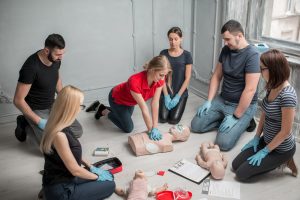While having a safe working environment should not only be desirable, it is also a legal obligation. The Health and Safety at Work etc. Act 1974 places a duty of care on employers to ensure the well-being of their staff.
In this article, we provide some practical tips and steps to help minimise risks in the workplace and create a safer working environment for all staff.
What are Workplace Risks?
A workplace risk is any potential hazard that could cause harm to employees. As you’ll read in this section, there are many different potential hazards that could put employees at risk. Understanding these risks is the first step in preventing workplace injuries and incidents.
Some of the most common workplace risks include:
- Physical Risks: Trip hazards, faulty machinery and electrical hazards could all put staff at risk of being injured in the workplace.
- Chemical Risks: Being exposed to harmful chemicals, vapours or fumes can result in serious injuries and illnesses.
- Ergonomic Risks: Musculoskeletal disorders can result from repetitive actions or poor workstation design.
- Hygiene Risks: Illnesses caused by bacteria, viruses and other pathogens in the workplace could all be caused by inadequate hygiene standards.
- Psychosocial Risks: Bullying, harassment and workplace stress can all significantly impact staff mental health and productivity.
While no workplace will ever be completely risk-free, it’s important for employers to do all they can to try and prevent workplace accidents. Proof of that, if needed, comes from Health and Safety Executive (HSE) data for workplace injuries in 2022/23. It shows that over 560,000 workers self-reported non-fatal injuries at work while employers reported a further 60,645 non-fatal injuries.
Conducting a Risk Assessment
Regular risk assessments are one of the best ways to identify workplace hazards, implement changes and make the workplace safer. They help employers comply with legal obligations and create a safer working environment.
Some of the steps involved in workplace risk assessments include:
- Identifying Hazards: This includes everything from physical objects to working practices that might cause harm.
- Identifying Those At Risk: To determine who might be affected by each hazard and how they might be harmed. This could include workers, customers and members of the public.
- Evaluating Risks: Assess the likelihood and severity of each risk. Implement precautions to reduce the risk to an acceptable level.
- Recording Findings and Implementing Them: Hazards should be documented and measures should be designed to reduce them. These measures should be implemented as quickly as possible and effectively.
Of course, risk assessments are not a one-off operation. They should be reviewed regularly and adapted where required.
Implementing Safety Measures
Even when a company conducts proper risk assessments, installs equipment that is fit for purpose and provides staff with PPE, accidents can still occur if proper safety measures are not implemented.
Some examples of the types of safety measures that could reduce risk in the workplace include:
Physical Safety Measures
Ensuring that all equipment is used correctly and maintained in line with the manufacturer’s guidelines is a good way of preventing accidents. Additionally, organising materials and storing them properly can reduce the chance of accidents, as clutter and poor organisation often lead to trip hazards and other risks.
Regular safety drills should also be conducted, as these help to prepare staff to respond quickly and effectively in the event of an emergency, potentially saving lives and minimising harm.
Chemical and Biological Safety Measures
Chemicals and other hazardous substances need to be labelled accurately and stored according to the manufacturer’s instructions to prevent spills or accidental exposure. In areas where dangerous chemicals are used, proper ventilation is essential to protect employees from inhaling harmful fumes.
Staff should also be trained on handling, storing, and disposing of these substances correctly. Effective training can significantly reduce the risks associated with chemical and biological hazards, creating a safer work environment.
Ergonomic Safety Measures
Work areas and workstations should be designed with ergonomics in mind to help prevent repetitive strain injuries (RSIs). This may involve providing adjustable monitors, ergonomic chairs, and specialised equipment such as ergonomic keyboards and mice.
Allowing staff regular breaks away from their workstations and encouraging stretching exercises can also help reduce physical strain and prevent injuries linked to repetitive tasks.
Psychosocial Safety Measures
Creating a positive work environment where employees feel valued and supported is essential for their mental well-being. Clear policies against bullying and harassment should be established, and staff should be made aware of the proper channels for reporting any issues. Additionally, employers can offer support for mental health challenges by providing access to counselling services or allowing mental health days when needed.
As an employer, implementing measures similar to those above could help to minimise risk in the workplace which, in turn, could lead to a more productive and happier workplace.
Employee Training and Education
Training is essential for ensuring employees understand what to do if an accident occurs in their workplace. Where companies invest in health and safety training, staff will know how to reduce the risk of accidents and should know how to deal with any emergencies that arise.
Importantly, health and safety training is not something that you only need to do once. To help staff remain vigilant, it is important to hold refresher sessions regularly and divulge the most up-to-date practices.
General safety training will be suitable for many workers but those working in high-risk roles may require specific safety training. For instance, staff who work at height may need to be trained on how to operate lifts or platforms and when to use a safety harness to protect them.
Where possible, companies should try to develop engaging and informative training programs. This might include a mix of methods including hands-on demos, videos and interactive sessions.
Emergency Preparedness
Having a proper emergency plan in place can significantly minimise risks in the workplace. Ideally, you should have emergency plans for various scenarios including fires, evacuations and medical emergencies. Importantly, these plans must be shared with all staff regularly.
To ensure that the emergency plans are understood, regular drills should be performed. This will make staff familiar with evacuation routes and congregation points. Of course, it is much better for lessons to be learned if something goes wrong in a drill than it is for a member of staff to be seriously injured in an emergency due to a lack of preparation.
To help with the emergency plan, it is vital that staff records and emergency contact lists are kept up to date and are accessible when required.
Creating a Safety Culture
As well as trying to make a workplace as safe as possible, employers should try to create a safety culture to try and minimise risk in the workplace. This means staff should be encouraged to report any hazards that they identify and they should feel able to suggest safety improvements to their supervisor.
In some cases, it may be a good idea to incentivise staff to work safely. For instance, staff could be singled out for praise if they constantly demonstrated safe working practices or their methods helped to prevent an accident at work.
To help foster a safe working culture, supervisors and managers should set a good example and promote a safety-first work environment. Essentially, workplace safety should be considered above and beyond any other factors when making decisions.
Regular Monitoring and Improvement
Even if your company has a good workplace safety record, it is important to monitor any safety measures you’ve implemented on a regular basis. This will allow you to check that they are working as intended and being followed by all staff. Any issues that are identified during these checks could allow you to clarify procedures or improve them to minimise risk in the workplace.
One good way to monitor workplace safety procedures is to ask staff for feedback. That’s because they are often at the coal face and are better positioned to identify hazards that supervisors might not be aware of.
If any safety procedures are updated or modified, it is important that the company’s health and safety policy is updated to reflect the changes. The new policy should be advertised to all staff (by email for instance) and be easily accessible to anyone who needs to read it.
Some examples of continuous improvement practices that can help to minimise risk in the workplace include:
- Safety audits: Regular safety audits can be used to identify potential improvements.
- Incident analysis: If a safety incident does occur, it should be analysed to a) understand what went wrong and b) allow changes to be made to prevent similar incidents in the future.
- Employee suggestion programs: It may be a good idea to implement programs or procedures that allow employees to suggest safety improvements.
As you can see, regular monitoring and improvement of a company’s health and safety procedures can be just as important as implementing them in the first place.
Closing Thoughts
There are several ways to minimise risk in the workplace, many of which we’ve discussed in this guide. The benefits of creating a safe working environment include a more productive workforce, better company reputation and, hopefully, bigger profits.
It is far better to be proactive when it comes to workplace health and safety rather than dealing with safety incidents as they happen.



